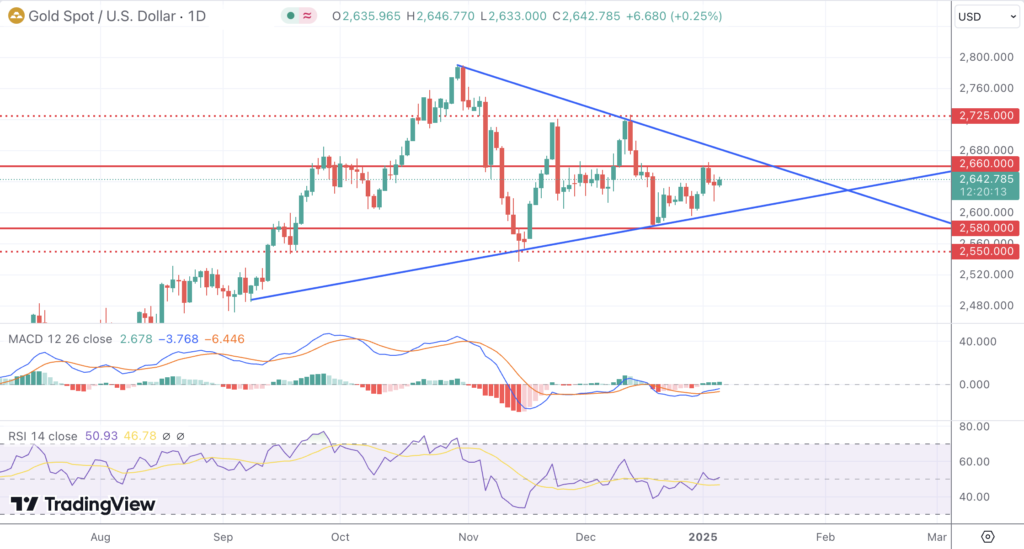Key Takeaways:
- Gold remains range-bound between $2,550 and $2,725, with $2,580 acting as a key support level and $2,660 as immediate resistance.
- Momentum indicators suggest a neutral bias, with no clear breakout signals yet evident.
- S. economic data, including inflation and retail sales, will be pivotal in shaping market expectations and gold’s trajectory.
- Persistent geopolitical risks provide a safety net for gold but lack the immediacy to drive substantial gains at this stage.
Market Dynamics and Recent Performance
Gold (XAU/USD) continues to trade sideways, reflecting mixed market sentiment and a lack of clear directional catalysts. The metal remains within a broad range between $2,550 and $2,725 as traders assess the interplay of safe-haven demand, inflation expectations, and evolving Federal Reserve policies. Softer U.S. economic data and easing bond yields provided modest support for gold, but the lack of a decisive bullish driver limited upward momentum. Persistent geopolitical risks, including tensions in Eastern Europe and the Middle East, continue to offer a baseline of demand for gold as a hedge against uncertainty.
Technical and Fundamental Influences
Gold’s technical outlook highlights a consolidative phase, with prices fluctuating within the $2,550-$2,725 range. The market has found support near $2,580, which aligns with the 50-day moving average and a significant Fibonacci retracement level. On the upside, resistance at $2,660 remains formidable, with additional barriers near $2,725. A breakout above this upper boundary would signal renewed bullish momentum, potentially opening the path to $2,800. Conversely, a breakdown below $2,550 could lead to a retest of $2,500, a critical psychological level.

Momentum indicators like the RSI suggest neutrality, reflecting the indecisive nature of recent price action. Meanwhile, the MACD shows a flattening trend, indicating that the market is awaiting stronger directional signals. Fundamentally, the softening U.S. PCE inflation data and slightly dovish Fed rhetoric provide mild tailwinds for gold. However, the dollar’s relative stability and robust U.S. labor market data counterbalance these supportive factors, keeping gold’s rally contained.
Geopolitical uncertainties and shifting risk sentiment further complicate the outlook. While global tensions remain elevated, their immediate impact on gold appears muted, suggesting that traders are prioritizing domestic economic developments over external risks.
Looking Forward
The coming week will be dominated by U.S. economic releases, including inflation data and retail sales figures, as well as continued Fed commentary. Markets will closely watch these indicators for clues about the central bank’s future policy direction. Softer-than-expected data could weaken the dollar and boost gold prices, while stronger figures may reinforce expectations of higher rates, pressuring the metal.
Gold’s ability to break out of its current range will also depend on developments in bond yields and risk appetite. Any resurgence of geopolitical tensions could provide a near-term lift for gold, while easing risks may diminish its appeal.

